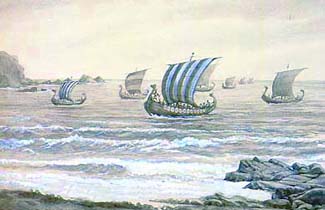Early Viking raids
Viking activity in Normandy intensified in the 9th Century and in 841 Rouen was sacked and the raiders overwintered in the area; in 845 they were operating on the Seine, and in 885 Paris was sacked. The Frankish monarchy was split and civil war allowed the Norse raiders to exploit an unstable situation.
A "jarl Hasting (Hastein)" was operating in the 850s and was responsible for the destruction of St Magloire’s monastery on Sark. Jersey-born poet Wace describes him as
"... ke firent la gent Sarrazine en Aureni, en Guernesi, en Sairc, en Erm, en Gersi..."
In legend, a jarl Godefroy Haraldsson appears as "Geoffroi de Grand Sarrazin" - a saracen meant any sea-raider - and is credited with having built a stronghold to dominate the western half of Guernsey on the site of Catel Church.
In 867 King Charles the Bald gave the Cotentin peninsula, which would have included the islands, to his vassal, King Saloman of Brittany. This would seem to indicate that the Carolingian king was under pressure from the east and delegated the western defences to his sub-kings while he concentrated on the major threat. This did not prove to be a successful ploy as in 878 the monks from Dol had to flee inland to Orleans. The Vikings occupied Brittany during the early tenth century until 939 when Alan Barbetorte aided by King Athelstan of England ended Viking rule.
Rollo
Essentially, the origins of the Duchy of Normandy was merely a recognition of fact by the Carolingian king, Charles the Simple. By the so called treaty of St Clair-sur-Epte in 911 the Frankish king was merely confirming ownership of the land around the mouth of the Seine between Rouen and Lisieux on the leader of a band of viking settlers in return for homage/loyalty and an instant conversion to Christianity. The leader of this band was called Hrolf Gangr, who went down in history under the more familiar name of Rollo.
As the land was already controlled by viking settlers and had been for at least 50 years Charles was not losing anything and was in fact gaining a "buffer state" across the mouth of the Seine, he had in effect turned the "poachers into gamekeepers".
Rollo’s land grab, later confirmed by the French king, was enlarged in 924 when he received more territory to the west as a reward for his continued loyalty. Again this land, especially the Bessin area around Bayeux, was in all probability already settled by Norse speaking settlers as this was to remain the Norse-speaking heartland of Normandy for the rest of the century. Dudo of St Quentin states that viking speech was dead in Rouen by 1025. It was, however, still being spoken in the more traditional Norse area of Bayeux.
In the 940s, following the assassination of Rollo’s son, Duke William Longsword, by Frenchmen there was a revival of Norse culture and a resurgence of the Thor cult. A fresh influx of immigrants from the Norse colonies in Ireland seem to have brought with them their Norse speaking wives, whereas the Norse settlement of Rouen was essentially a male affair, which resulted in intermarriage and children being brought up by French speaking mothers.

